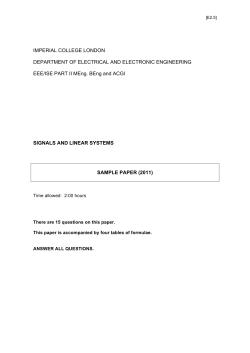
MNB1501 Business Management 1A lesson plan
MNB1501 Business Management 1A lesson plan Activity Welcome General course information aspects covered introduction , credentials experience contact details / preferred communication method Housekeeping rules The tutorial material for MNB101 consists of three prescribed books, one study guide and several tutorial letters. The prescribed textbooks for this module are: person responsible Tutor Tutor and Students Tutor 1. Du Toit, GS, Erasmus, BJ & Strydom, JW. 2010. Introduction to Business Management. 9th edition. Cape Town: Oxford University Press. (chapters 1-9 in the 8th edition; and chapters 1-5, 710 in the 9th edition) 2. Strydom, JW & Rudansky-Kloppers, S. 2013. Multiplechoice questions for Introduction to Business Management. 2 ND edition. Cape Town: Oxford University Press. 3. Rudansky-Kloppers, S. 2012 Business Cases. Cape Town: Oxford University Press. Assignments- submission, contribution to coursework Exam : 1 paper multiple choice and 70 questions 2 hours Breakdown of Course material 3 study units per session 2 sessions for revision purposes Tutor: Linear Zhou Rustenburg tutor Tutorial Tutorial 1 Tutorial 1 Study unit and related chapter of prescribed textbook to be covered and other instructions General discussion and overview of MNB1501 explaining the pitfalls in completing Multiple choice questions for the assignments covering basically all chapters. Study unit 1: The business world and business management Tutorial 1 Study unit 2: Entrepreneurship Tutorial 1 Study unit 3: Establishing a business Tutorial 52 Study unit 4: The business environment Tutor: Linear Zhou Rustenburg Content of discussions: By the end of the lesson the Student will; Tutor will ;Instruct students to take notice of the listed outcomes in each study unit as an indication of what aspects need to be more emphasized regarding each study unit but should not be exclusively studied. : By the end of the lesson the Student(s) will; demonstrate an understanding of the role of business in society explain the needs of society and how need satisfaction occurs discuss the three main economic systems in the world explain the differences between need-satisfying institutions and non-profit institutions explain the inherent nature of business management and elaborate on how the study material for business management is classified explain the concept of entrepreneurship and the entrepreneurial process define an entrepreneur describe the roles that entrepreneurs and smallbusiness owners play in the South African economy discuss how to become an entrepreneur discuss the skills and resources required to become an entrepreneur distinguish between and describe the different ways in which an entrepreneur may start a business discuss the implications of choosing a specific business opportunity identify the factors that influence the location of a business distinguish between the different forms of ownership that are found in South Africa discuss the key considerations that are applicable when a form of business has to be chosen describe the objectives of, importance of and need for a business plan describe the various components that compose the business plan write up a business plan explain the meaning of environmental change explain the nature and composition of the business environment discuss each of the components of the environmental model explain how each of the environmental variables can impact on an industry or an individual business describe some ways in which management should respond to the influences of the environment Tutorial 2 Study unit 5: Corporate social responsibility Tutorial 2 Study unit 6: Planning Tutorial 3 Study unit: 7 Organising Tutorial 3 Study unit: 8 Leading Tutor: Linear Zhou Rustenburg distinguish between the different terms and concepts in the field of corporate social responsibility discuss the imperatives for good corporate social responsibility in South Africa draw up a stakeholder map for an organization, indicating the different categories of stakeholders explain the business case for corporate social responsibility as it relates to the various business functions explain why planning is needed in the organization explain what a goal is discuss the steps in the planning process compare the different organizational goals as used by top, middle and lower management discuss the requirements that must be met when setting goals compare the different plans that can be used by the organization differentiate between strategic, functional and operational planning analyse organizing as a management task, including contemporary structures and design, demonstrating how this serves as a framework for the activities of the organization explain the concepts of organizing and organizational structure describe the importance of organizing discuss the fundamentals of organizing explain how an organization evolves from a single entrepreneur organization into a large organization identify and explain the factors that influence organizational design analyse leadership as a management task, by (1) explaining the meaning of concepts such as leadership, authority, power, influence, delegation, responsibility and motivation, and (2) differentiating between leadership and management discuss basic leadership models, by referring to the factors influencing effective leadership demonstrate an understanding of motivation as a key role of a leader by describing the fundamental model of motivation describe a simple communication model discuss groups in the organization, by referring to (1) the reasons why groups are formed, (2) the kinds of groups, and (3) the characteristics of groups differentiate between groups and teams in the organization Tutorial 3 Study unit 9: Controlling the management process Tutorial 4 Revision of study units 1-3 Tutorial 4 Revision of study units 4-6 Tutorial 5 Revision of study units 7-9 Tutorial 5 Revision and exam discussion Tutorial 5 Study unit and related chapter of prescribed textbooks to be covered and other instructions Tutor: Linear Zhou Rustenburg analyse control as a management task, by (1) explaining the task of control and its purpose, and (2) describing how a control process should function illustrate how the task of control forms an integral part of the planning process explain the various types of control discuss the characteristics of an effective control system describe how the control process provides feedback for the revision of planning
© Copyright 2025





















